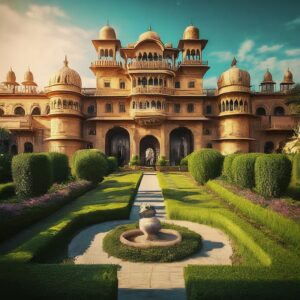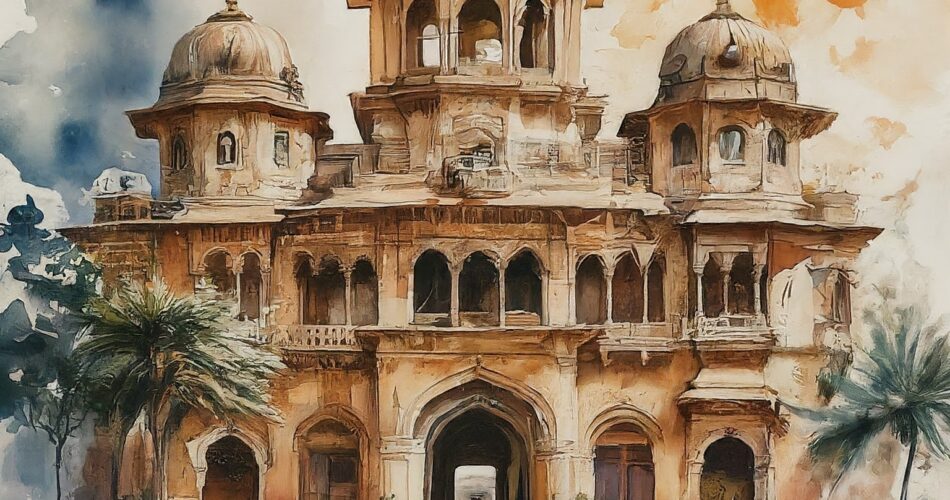Gracing the vibrant city of Vadodara in Gujarat, India, the Laxmi Vilas Palace stands as a majestic testament to architectural brilliance and regal history. Built in 1890 by the Gaekwad dynasty, this sprawling palace complex remains a captivating landmark, attracting visitors with its rich heritage, exquisite design, and captivating grandeur.

A Legacy Etched in Stone: The History of Laxmi Vilas Palace
The story of Laxmi Vilas Palace unfolds with Maharaja Sayajirao Gaekwad III, the visionary ruler of Baroda State. Driven by a desire to create a magnificent palace that reflected the opulence and progress of his reign, Maharaja Sayajirao Gaekwad III commissioned the construction in 1890. Major Charles Mant, a British architect, was entrusted with the task of bringing the Maharaja’s vision to life. The palace’s construction, completed in 1890, was a monumental undertaking, taking four years and a staggering cost of £180,000 (₹27,00,000) at the time.
A Fusion of Architectural Grandeur: The Indo-Saracenic Marvel
Laxmi Vilas Palace exemplifies the architectural style known as Indo-Saracenic Revival. This unique style seamlessly blends elements of Indian, Islamic, and European architectural traditions. The palace’s imposing facade showcases a majestic blend of red sandstone and white marble, adorned with intricate carvings and sculptures. The towering clock tower, reminiscent of Big Ben in London, adds a touch of British influence.
Step inside the palace, and you’re transported into a world of opulent interiors. Italian marble, Belgian stained glass windows, and exquisite Venetian chandeliers create an atmosphere of awe-inspiring grandeur. The intricate mosaic work and ornately decorated ceilings leave no detail untouched.
A Glimpse into Royal Life: Exploring the Palace Interiors
While only a portion of the palace is open to the public, the accessible areas offer a captivating glimpse into the lives of the Gaekwads. The Durbar Hall, the center of royal court proceedings, boasts a magnificent Italian marble throne and a collection of impressive paintings by Raja Ravi Verma, a renowned Indian artist. The Armoury Hall showcases a fascinating collection of weapons and artifacts, whispering tales of battles fought and victories won.
The palace also houses a remarkable collection of European and Indian artworks, objets d’art, and furniture. Visitors can marvel at the intricate details of Belgian tapestries, admire the craftsmanship of Italian marble statues, and appreciate the grandeur of European furniture.
Beyond the Grand Walls: Exploring the Palace Grounds
The expansive palace complex of over 500 acres extends far beyond the majestic walls. Lush green gardens, meticulously maintained, offer a serene escape. Visitors can take leisurely walks amidst the vibrant flora or enjoy a tranquil moment by the fountains. The complex also houses the Moti Baug Palace, a smaller palace known for its exquisite design, and the Maharaja Fateh Singh Museum building, showcasing a collection of royal artifacts.
A Legacy that Lives On: The Significance of Laxmi Vilas Palace
Today, the Laxmi Vilas Palace stands not just as a monument to a bygone era but also as a symbol of Vadodara’s rich heritage. The palace continues to be the residence of the Gaekwad family, who are still held in high esteem by the city’s residents.
Laxmi Vilas Palace offers a unique opportunity to delve into the fascinating world of Indian royalty. It’s a place where history whispers through the grand halls, where art comes alive in every detail, and where the echoes of a glorious past resonate in the present.
Planning Your Visit to Laxmi Vilas Palace
The Laxmi Vilas Palace is open to the public from 9:30 AM to 5:00 PM, with a lunch break from 1:00 PM to 1:30 PM. Photography is not permitted inside the palace but is allowed in the grounds. It’s advisable to allocate around 2 hours for your visit to fully appreciate the palace’s grandeur.
Here are some additional tips for planning your visit:
- Audio Guides: The palace offers complimentary audio guides in English, Hindi, and Marathi, providing insightful information about the palace’s history and architecture.
- Dress Code: While there’s no strict dress code, modest clothing is recommended.
- Accessibility: Limited wheelchair accessibility is available within the palace.
In Conclusion: The Enduring Enchantment of Laxmi Vilas Palace
The Laxmi Vilas Palace is more than just a magnificent structure; it’s a captivating tapestry woven with history, art, and architectural brilliance. A visit to this iconic landmark is an enriching experience that leaves a lasting impression. So,
Know more about Laxmi Vilas Palace
